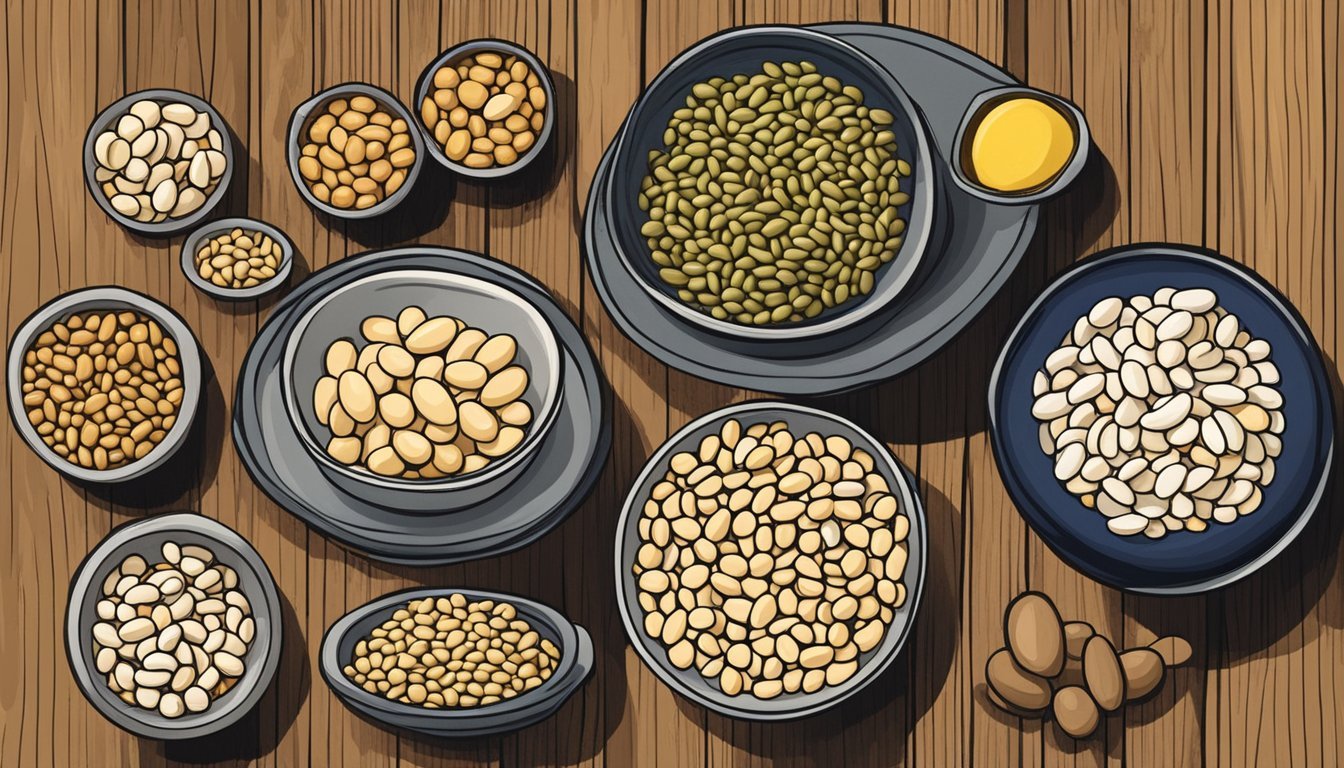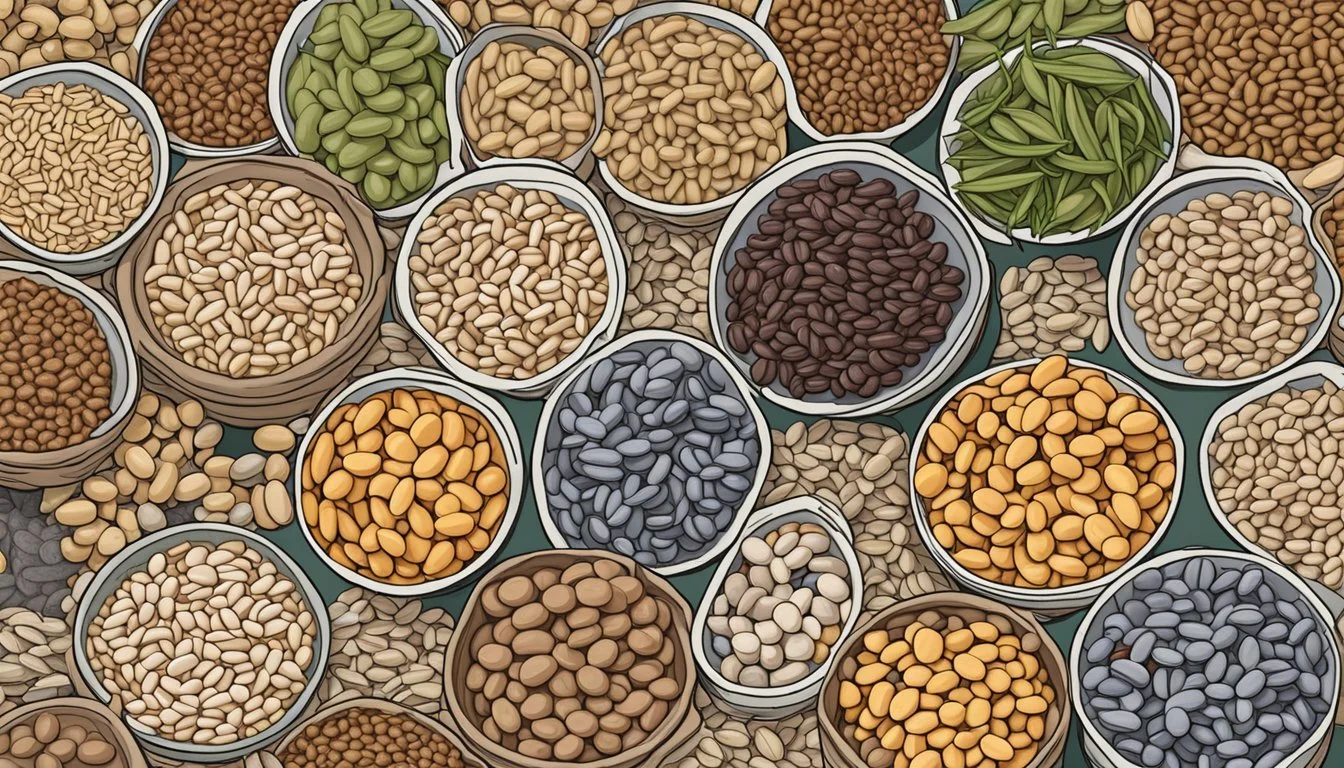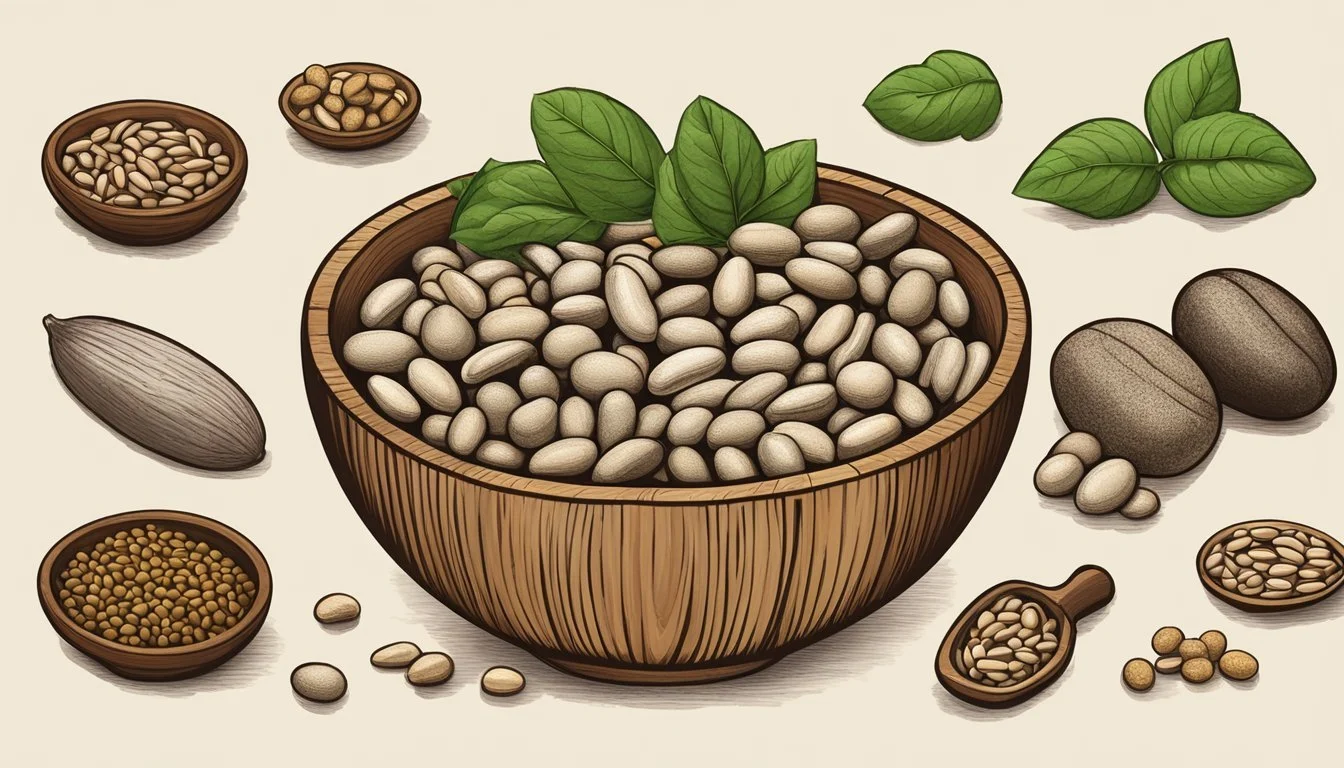Great Northern Beans Substitutes
Best Alternatives for Any Recipe
Great Northern beans are a staple in many kitchens due to their mild flavor and versatility in a variety of dishes. When you're out of these beans or looking for something different, there are several substitutes that can seamlessly fit into your recipes. Cannellini beans, also known as white kidney beans, are a prominent substitute due to their similar texture and nutty flavor.
Other options include navy beans and pinto beans, both of which provide a comparable texture and cooking time, making them excellent alternatives in soups, stews, and salads. From a nutritional standpoint, Great Northern beans and their substitutes are rich in dietary fiber and protein, contributing to a healthy diet by offering essential micronutrients like potassium, iron, and magnesium.
Exploring alternatives such as chickpeas, black beans, and lima beans can not only diversify your meals but also ensure you still receive a good supply of vitamins and minerals. Each bean variety brings its unique taste and texture, allowing for creative culinary experimentation while maintaining nutritional benefits.
Understanding Great Northern Beans
Great Northern beans are distinct for their nutty flavor and versatility, offering a range of nutritional benefits and culinary uses.
Characteristics and Nutritional Profile
Great Northern beans are medium-sized, white legumes known for their mild, nutty flavor and smooth texture. They have a firm exterior that holds up well in cooking, which makes them ideal for a variety of dishes.
Nutritionally, these beans are packed with fiber, which aids in digestion and helps maintain steady blood sugar levels. They are an excellent source of plant-based protein, crucial for muscle repair and growth.
In addition, Great Northern beans contain significant amounts of iron, magnesium, phosphorus, and potassium. These essential minerals contribute to various bodily functions, from oxygen transport to bone health.
Culinary Uses
Great Northern beans are incredibly versatile in the kitchen. Their mild flavor and firm texture make them suitable for soups, stews, casseroles, and salads. They are often used in chili and baked bean recipes due to their ability to absorb flavors well.
They can be mashed and used as a base for dips or spreads. When cooked, they maintain their shape and texture, which adds a pleasant mouthfeel to a variety of dishes.
These beans are also a popular choice for vegan and vegetarian dishes, providing a hearty and nutritious alternative to animal proteins. Whether used in traditional recipes or innovative culinary creations, Great Northern beans offer both flavor and nutrition.
Popular Substitutes for Great Northern Beans
Great Northern beans are known for their mild flavor and creamy texture. When a recipe calls for these beans, but they're unavailable, several other types of beans can stand in as excellent substitutes.
Cannellini Beans
Cannellini Beans, also known as white kidney beans, are a great alternative. They are similar in size and color to Great Northern beans. Cannellini beans have a smooth texture and a slightly nutty flavor. They absorb flavors well, making them ideal for soups, stews, and casseroles. Additionally, they are rich in fiber and protein, adding nutritional value to dishes.
Navy Beans
Navy beans are small, white beans that can substitute for Great Northern beans in various dishes. They have a mild flavor and a creamy texture that works well in soups, salads, chili, and pasta. Navy beans are a powerhouse of nutrients, including fiber, magnesium, and iron, making them a healthy choice for any meal.
Pinto Beans
Pinto beans offer a richer, earthier flavor compared to Great Northern beans. These beans are spotted with brown and turn a solid light brown when cooked. Pinto beans are commonly used in Mexican cuisine but can be adapted for use in soups, stews, and salads. They are high in protein and fiber, contributing to a balanced diet.
Black Beans
Black beans are smaller and darker but can be used as a substitute for their distinctive earthy flavor. These beans add color and a different taste profile to dishes. They are versatile and can be used in soups, salsas, and salads. Black beans are also highly nutritious, providing a good source of protein and fiber.
Kidney Beans
Kidney beans are larger and have a more robust flavor compared to Great Northern beans. They come in red and dark red varieties and are shaped like kidneys. These beans are common in dishes like chili and stews. Kidney beans are rich in protein and fiber, helping to keep you full and nourished.
Lima Beans
Lima beans, also known as butter beans, have a creamy texture and a slightly sweet, nutty flavor. They can substitute for Great Northern beans in casseroles and soups. Lima beans are a good source of dietary fiber, protein, and various vitamins, making them a healthy substitution option.
Chickpeas
Chickpeas, or garbanzo beans, have a firmer texture and a slightly nutty and earthy flavor. They work well in dishes where a bit of extra texture is welcome, such as salads, soups, and stews. Chickpeas are loaded with protein and fiber, enhancing the nutritional profile of meals.
Fava Beans
Fava beans have a distinct flavor that is both nutty and slightly sweet. They can be used in place of Great Northern beans, especially in Mediterranean dishes. Fava beans are low in calories but high in protein and fiber, making them suitable for various dietary needs.
Black-Eyed Peas
Black-eyed peas have a slightly earthy flavor and a fairly smooth texture. They work well in salads, soups, and stews. These peas are nutritious and provide a good amount of protein, fiber, and essential nutrients, making them a great substitute for Great Northern beans.
Adzuki Beans
Adzuki beans are small and red but can be used as an alternative in many dishes. They have a sweet and nutty flavor and are common in Asian cuisine. These beans are high in protein and fiber and provide a different flavor profile, adding variety to your meals.
Flageolet Beans
Flageolet beans are small, pale green beans that offer a delicate, mild flavor. They are often used in French cuisine and can substitute for Great Northern beans in soups and stews. Flageolet beans are highly nutritious, offering a good source of protein and fiber.
Butter Beans
Butter beans, also known as large lima beans, offer a buttery, creamy texture that is similar to Great Northern beans. These beans are excellent in soups, casseroles, and salads. They provide a good amount of dietary fiber, protein, and essential vitamins, making them a nutritious substitution option.
Considering Flavors and Textures
When substituting Great Northern beans, it's essential to find replacements that not only match their nutty flavor but also achieve the right creamy texture. The following sections provide detailed insights into selecting the best substitutes.
Matching the Nutty Flavor
To match the nutty flavor of Great Northern beans, Cannellini beans and Chickpeas are excellent choices. Cannellini beans, also known as white kidney beans, offer a mild and slightly nutty flavor, making them suitable for soups and stews.
Chickpeas, with their earthy and nutty taste, provide a robust flavor that complements various dishes, from salads to casseroles. Another viable option is Fava beans, which have a slightly sweeter undertone but still provide that desired nutty essence. These beans are versatile and can be used in both sweet and savory recipes.
Achieving the Right Texture
Achieving the creamy texture similar to Great Northern beans can be done with Navy beans and Cannellini beans. Navy beans are soft and creamy, making them perfect for baked beans and dips. Their ability to soak up flavors makes them an ideal substitute in chili and soups.
Cannellini beans also have a smooth texture that fits well in stews and casseroles. They blend seamlessly into dishes, providing a creamy consistency. For a softer alternative, Pinto beans can be used; they have a creamy texture and are excellent in various dishes from Mexican cuisine to hearty soups.
Dishes and Recipes Advice
When substituting Great Northern beans, consider the texture and flavor of the alternative beans to ensure harmony in your dishes. Versatile substitutes like cannellini beans and chickpeas can fit well into soups, salads, baked dishes, and even international recipes, each bringing its own unique characteristics.
Substitutes in Soups and Stews
Cannellini beans are an excellent substitute in soups and stews. They have a similar texture to Great Northern beans and absorb flavors well. Navy beans are another good choice due to their quick cooking time and ability to blend seamlessly into brothy dishes.
Fava beans offer a distinct sweetness making them suitable for more flavor-concentrated stews. Chickpeas add a nutty, earthy flavor, enriching the base of the soup or stew.
Example:
Italian Minestrone with cannellini beans
Moroccan Chickpea Stew
Substitutes in Salads and Side Dishes
In salads and side dishes, the texture of the substitute bean plays a significant role. Chickpeas work well due to their firm texture and nutty flavor. Pinto beans are another versatile option, adding a creamy texture.
Fava beans can bring a touch of sweetness to cold dishes. Adjust seasoning to enhance the natural flavors of these substitutes.
Example:
Mediterranean Chickpea Salad
Three-Bean Salad with pinto beans
Baked Beans and Casseroles
Cannellini beans are useful in baked beans and casseroles for their sturdy texture and subtle flavor. They mimic the consistency of Great Northern beans. Navy beans are also suitable, offering a delicately mild taste that works well in Southern baked bean recipes.
Consider using fava beans in casseroles for additional protein and sweetness.
Example:
Southern Baked Beans with navy beans
Bean and Vegetable Casserole with cannellini beans
Dips, Spreads, and Hummus
For dips and spreads, creamy beans such as cannellini and chickpeas are ideal. Cannellini beans create smooth, velvety textures ideal for spreads. Chickpeas are the primary ingredient in traditional hummus, known for their nutty flavor and creamy consistency.
When making bean-based dips, blending these beans with garlic, olive oil, and lemon juice produces rich and flavorful spreads.
Example:
White Bean Dip with cannellini beans
Classic Hummus using chickpeas
International Cuisine Variations
Various international dishes benefit from these substitutes. Cannellini beans work well in Italian cuisine, featured in dishes like Tuscan bean soup. In Mexican cuisine, pinto beans are commonly used in refried beans and tacos.
Chickpeas thrive in Middle Eastern and Mediterranean dishes, making an appearance in falafel or as a meat substitute in curries.
Example:
Tuscan Bean Soup with cannellini beans
Falafel with chickpeas
Health and Nutrition Considerations
When considering substitutes for Great Northern beans, it's crucial to look into their health and nutrition benefits. This includes factors like dietary fiber content, protein for muscle formation, essential vitamins and minerals, and options that support heart health through low sodium content.
Dietary Fiber Content
Dietary fiber is key for digestive health and maintaining stable blood sugar levels. Many substitutes for Great Northern beans, such as navy beans, pinto beans, and chickpeas, provide substantial fiber. Navy beans, for instance, are recognized for their high dietary fiber, aiding in smoother digestion and longer-lasting satiety. Fiber also supports weight management and lowers cholesterol levels, making these substitutes excellent for promoting overall well-being.
Protein for Muscle Formation
Protein is essential for muscle repair and growth. Most legume substitutes for Great Northern beans, like cannellini beans and fava beans, are rich in protein. Cannellini beans contain around 15 grams of protein per cup, making them a great option for vegetarians and those looking to increase protein intake. Integrating these beans into the diet helps support muscle mass, especially in physically active individuals.
Vitamins and Minerals
Substitutes for Great Northern beans offer various essential vitamins and minerals that are vital for health. For example, beans such as chickpeas and fava beans are rich in magnesium, phosphorus, potassium, and iron. These nutrients play critical roles in metabolic processes, bone health, and preventing anemia. Additionally, many of these beans contain folate, which is crucial for DNA synthesis and repair, particularly important during pregnancy.
Low Sodium Options for Heart Health
Low sodium intake is important for maintaining heart health and controlling blood pressure. Thankfully, many Great Northern bean substitutes like navy beans and chickpeas naturally have lower sodium content. These low sodium options are beneficial for individuals with high blood pressure or those seeking to reduce their risk of cardiovascular diseases. By incorporating these beans, one can enhance heart health without compromising on flavor and nutritional value.
Practical Cooking Tips
When substituting Great Northern beans in recipes, it is crucial to consider cooking times and preparation methods. Different beans have unique characteristics that can impact your dishes.
Assessing Cooking Times
Different beans have varying cooking times. For instance, navy beans typically cook faster than Great Northern beans. When using navy beans as a substitute, monitor them closely to prevent overcooking.
For beans like cannellini or chickpeas, cooking times are generally similar to Great Northern beans. It is advised to simmer gently and test for doneness periodically. This ensures your beans are tender but not mushy.
Using a pressure cooker can help speed up the process. Be mindful of added herbs and spices, as pressure cooking can intensify their flavors.
Soaking and Preparation
Soaking your beans before cooking is essential to ensure even texture and quicker cooking. Most beans, including pinto and cannellini, benefit from an overnight soak in cold water.
If short on time, a quick soak method works well—boil the beans for a couple of minutes, then let them sit in hot water for an hour. Discarding the soaking water can also help reduce bloating and improve digestion.
For those replacing Great Northern beans in hearty dishes like soups or stews, adding meat, vegetables, or additional spices during the soaking process can enhance flavor integration. This ensures your bean dishes maintain their intended flavor profile.
Dietary and Lifestyle Adaptation
Great Northern beans offer various health benefits, but there are several substitutes that can suit different dietary and lifestyle needs, including vegetarian and vegan diets, weight management goals, and allergy considerations.
Vegetarian and Vegan Alternatives
Navy beans and chickpeas are excellent vegetarian and vegan substitutes for Great Northern beans. They both provide high levels of dietary fiber and protein, which are essential for muscle repair and digestion. Navy beans are low in sodium which is beneficial for blood pressure management. Chickpeas, with their nutty and earthy flavor, complement a variety of dishes, adding nutritional value without the need for animal products.
Weight Management Options
For those looking to lose weight, fava beans and black beans are ideal substitutes. Fava beans have low calories but are rich in protein and fiber, promoting a feeling of fullness. Black beans contain dietary fiber that aids digestion and helps regulate blood sugar levels, making them suitable for weight control. They also provide essential nutrients like iron and magnesium, supporting overall metabolic health.
Allergy and Intolerance Considerations
For individuals with allergies or intolerances, finding the right bean substitute is crucial. Cannellini beans and kidney beans can be safe alternatives. Both are legumes with a texture similar to Great Northern beans. Cannellini beans are particularly gentle on the digestive system, while kidney beans offer a robust nutritional profile with dietary fiber and protein. Always ensure to verify any specific allergies or intolerances to different legumes.
Comparing Bean Varieties
When considering substitutes for Great Northern beans, it's important to look at how they compare to other white beans and examine differences in texture and flavor.
Great Northern Beans Vs. Other White Beans
Great Northern beans often get compared to other white beans like Navy beans and Cannellini beans. Great Northern beans are medium-sized, while Cannellini beans are larger and Navy beans are smaller. They are widely used in soups, chili, and stews for their delicate flavor and creamy texture.
Unlike Great Northern beans, Navy beans have a denser texture and a slightly milder taste, making them excellent in baked beans and casseroles. Cannellini beans, also known as white kidney beans, have a more robust, nutty flavor and a creamy, tender texture, making them suitable for Italian dishes like minestrone soup.
Texture and Flavor Differences
Texture greatly influences how these beans are used in various recipes. Great Northern beans have a creamy texture, which works wonderfully in dishes that require a softer, more blended consistency. In contrast, Navy beans hold their shape better and provide a firmer bite, which is ideal for hearty soups and stews.
Flavor differences are notable as well. Great Northern beans have a mild, slightly nutty flavor. Pinto beans and Chickpeas can serve as substitutes but bring different flavor profiles to the table. Pinto beans are earthier, while chickpeas, noted for their ancient culinary use, offer a nutty, somewhat sweet taste that complements dishes like salads and hummus.
Sustainable and Budget-Friendly Shopping
Maintaining a sustainable and budget-friendly pantry involves strategies such as buying beans in bulk and choosing seasonal and local bean varieties. These practices not only save money but also ensure you have nutritious options on hand year-round.
Buying Beans in Bulk
Buying beans in bulk can be a smart way to save money while ensuring a steady supply of protein and dietary fiber. Bulk purchases often come at a lower per-unit cost compared to smaller packages.
Stores with bulk sections allow shoppers to buy precise amounts, reducing waste. This approach also cuts down on packaging, promoting environmental sustainability. Additionally, storing beans in airtight containers keeps them fresh for longer periods, ensuring nutritional value isn't compromised.
Seasonal and Local Bean Varieties
Choosing seasonal and locally grown beans supports both the budget and the environment. Seasonal beans are often fresher and cheaper because they don't have the added costs of off-season production or long-distance shipping.
Local beans, cultivated in North America, for example, can be more affordable and readily available. Moreover, they often contain fewer preservatives. Opting for these beans supports local farmers and reduces the carbon footprint associated with food transportation. Local varieties might also offer unique flavors and better nutrition profiles, enriched with the soil's local minerals.






